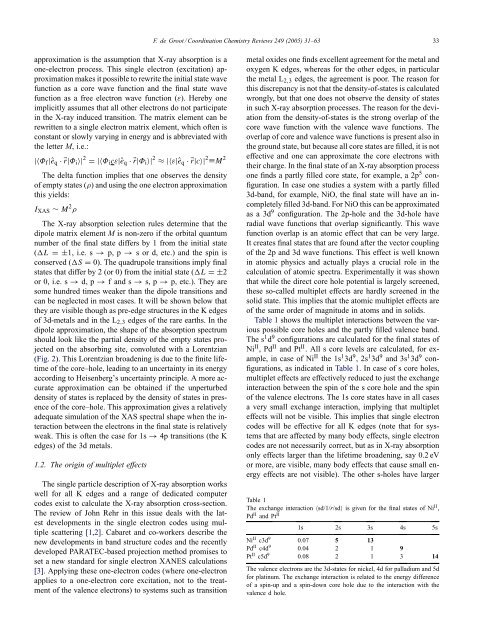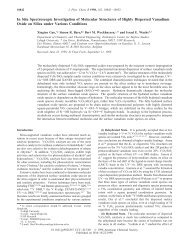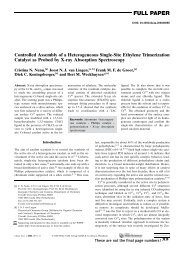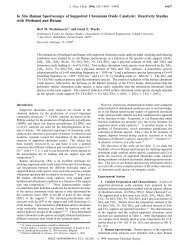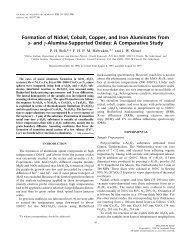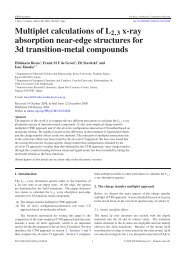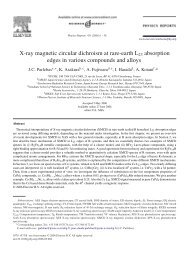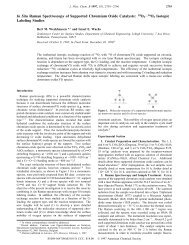Multiplet Effects in X-ray Absorption - Inorganic Chemistry and ...
Multiplet Effects in X-ray Absorption - Inorganic Chemistry and ...
Multiplet Effects in X-ray Absorption - Inorganic Chemistry and ...
You also want an ePaper? Increase the reach of your titles
YUMPU automatically turns print PDFs into web optimized ePapers that Google loves.
F. de Groot / Coord<strong>in</strong>ation <strong>Chemistry</strong> Reviews 249 (2005) 31–63 33approximation is the assumption that X-<strong>ray</strong> absorption is aone-electron process. This s<strong>in</strong>gle electron (excitation) approximationmakes it possible to rewrite the <strong>in</strong>itial state wavefunction as a core wave function <strong>and</strong> the f<strong>in</strong>al state wavefunction as a free electron wave function (ε). Hereby oneimplicitly assumes that all other electrons do not participate<strong>in</strong> the X-<strong>ray</strong> <strong>in</strong>duced transition. The matrix element can berewritten to a s<strong>in</strong>gle electron matrix element, which often isconstant or slowly vary<strong>in</strong>g <strong>in</strong> energy <strong>and</strong> is abbreviated withthe letter M, i.e.:|〈Φ f |ê q ·⃗r|Φ i 〉| 2 =|〈Φ i cε|ê q ·⃗r|Φ i 〉| 2 ≈|〈ε|ê q ·⃗r|c〉| 2 ≡M 2The delta function implies that one observes the densityof empty states (ρ) <strong>and</strong> us<strong>in</strong>g the one electron approximationthis yields:I XAS ∼ M 2 ρThe X-<strong>ray</strong> absorption selection rules determ<strong>in</strong>e that thedipole matrix element M is non-zero if the orbital quantumnumber of the f<strong>in</strong>al state differs by 1 from the <strong>in</strong>itial state(L =±1, i.e. s → p, p → s or d, etc.) <strong>and</strong> the sp<strong>in</strong> isconserved (S = 0). The quadrupole transitions imply f<strong>in</strong>alstates that differ by 2 (or 0) from the <strong>in</strong>itial state (L =±2or 0, i.e. s → d, p → f <strong>and</strong> s → s, p → p, etc.). They aresome hundred times weaker than the dipole transitions <strong>and</strong>can be neglected <strong>in</strong> most cases. It will be shown below thatthey are visible though as pre-edge structures <strong>in</strong> the K edgesof 3d-metals <strong>and</strong> <strong>in</strong> the L 2,3 edges of the rare earths. In thedipole approximation, the shape of the absorption spectrumshould look like the partial density of the empty states projectedon the absorb<strong>in</strong>g site, convoluted with a Lorentzian(Fig. 2). This Lorentzian broaden<strong>in</strong>g is due to the f<strong>in</strong>ite lifetimeof the core–hole, lead<strong>in</strong>g to an uncerta<strong>in</strong>ty <strong>in</strong> its energyaccord<strong>in</strong>g to Heisenberg’s uncerta<strong>in</strong>ty pr<strong>in</strong>ciple. A more accurateapproximation can be obta<strong>in</strong>ed if the unperturbeddensity of states is replaced by the density of states <strong>in</strong> presenceof the core–hole. This approximation gives a relativelyadequate simulation of the XAS spectral shape when the <strong>in</strong>teractionbetween the electrons <strong>in</strong> the f<strong>in</strong>al state is relativelyweak. This is often the case for 1s → 4p transitions (the Kedges) of the 3d metals.1.2. The orig<strong>in</strong> of multiplet effectsThe s<strong>in</strong>gle particle description of X-<strong>ray</strong> absorption workswell for all K edges <strong>and</strong> a range of dedicated computercodes exist to calculate the X-<strong>ray</strong> absorption cross-section.The review of John Rehr <strong>in</strong> this issue deals with the latestdevelopments <strong>in</strong> the s<strong>in</strong>gle electron codes us<strong>in</strong>g multiplescatter<strong>in</strong>g [1,2]. Cabaret <strong>and</strong> co-workers describe thenew developments <strong>in</strong> b<strong>and</strong> structure codes <strong>and</strong> the recentlydeveloped PARATEC-based projection method promises toset a new st<strong>and</strong>ard for s<strong>in</strong>gle electron XANES calculations[3]. Apply<strong>in</strong>g these one-electron codes (where one-electronapplies to a one-electron core excitation, not to the treatmentof the valence electrons) to systems such as transitionmetal oxides one f<strong>in</strong>ds excellent agreement for the metal <strong>and</strong>oxygen K edges, whereas for the other edges, <strong>in</strong> particularthe metal L 2,3 edges, the agreement is poor. The reason forthis discrepancy is not that the density-of-states is calculatedwrongly, but that one does not observe the density of states<strong>in</strong> such X-<strong>ray</strong> absorption processes. The reason for the deviationfrom the density-of-states is the strong overlap of thecore wave function with the valence wave functions. Theoverlap of core <strong>and</strong> valence wave functions is present also <strong>in</strong>the ground state, but because all core states are filled, it is noteffective <strong>and</strong> one can approximate the core electrons withtheir charge. In the f<strong>in</strong>al state of an X-<strong>ray</strong> absorption processone f<strong>in</strong>ds a partly filled core state, for example, a 2p 5 configuration.In case one studies a system with a partly filled3d-b<strong>and</strong>, for example, NiO, the f<strong>in</strong>al state will have an <strong>in</strong>completelyfilled 3d-b<strong>and</strong>. For NiO this can be approximatedasa3d 9 configuration. The 2p-hole <strong>and</strong> the 3d-hole haveradial wave functions that overlap significantly. This wavefunction overlap is an atomic effect that can be very large.It creates f<strong>in</strong>al states that are found after the vector coupl<strong>in</strong>gof the 2p <strong>and</strong> 3d wave functions. This effect is well known<strong>in</strong> atomic physics <strong>and</strong> actually plays a crucial role <strong>in</strong> thecalculation of atomic spectra. Experimentally it was shownthat while the direct core hole potential is largely screened,these so-called multiplet effects are hardly screened <strong>in</strong> thesolid state. This implies that the atomic multiplet effects areof the same order of magnitude <strong>in</strong> atoms <strong>and</strong> <strong>in</strong> solids.Table 1 shows the multiplet <strong>in</strong>teractions between the variouspossible core holes <strong>and</strong> the partly filled valence b<strong>and</strong>.The s 1 d 9 configurations are calculated for the f<strong>in</strong>al states ofNi II ,Pd II <strong>and</strong> Pt II . All s core levels are calculated, for example,<strong>in</strong> case of Ni II the 1s 1 3d 9 ,2s 1 3d 9 <strong>and</strong> 3s 1 3d 9 configurations,as <strong>in</strong>dicated <strong>in</strong> Table 1. In case of s core holes,multiplet effects are effectively reduced to just the exchange<strong>in</strong>teraction between the sp<strong>in</strong> of the s core hole <strong>and</strong> the sp<strong>in</strong>of the valence electrons. The 1s core states have <strong>in</strong> all casesa very small exchange <strong>in</strong>teraction, imply<strong>in</strong>g that multipleteffects will not be visible. This implies that s<strong>in</strong>gle electroncodes will be effective for all K edges (note that for systemsthat are affected by many body effects, s<strong>in</strong>gle electroncodes are not necessarily correct, but as <strong>in</strong> X-<strong>ray</strong> absorptiononly effects larger than the lifetime broaden<strong>in</strong>g, say 0.2 eVor more, are visible, many body effects that cause small energyeffects are not visible). The other s-holes have largerTable 1The exchange <strong>in</strong>teraction 〈sd/1/r/sd〉 is given for the f<strong>in</strong>al states of Ni II ,Pd II <strong>and</strong> Pt II 1s 2s 3s 4s 5sNi II c3d 9 0.07 5 13Pd II c4d 9 0.04 2 1 9Pt II c5d 9 0.08 2 1 3 14The valence electrons are the 3d-states for nickel, 4d for palladium <strong>and</strong> 5dfor plat<strong>in</strong>um. The exchange <strong>in</strong>teraction is related to the energy differenceof a sp<strong>in</strong>-up <strong>and</strong> a sp<strong>in</strong>-down core hole due to the <strong>in</strong>teraction with thevalence d hole.


